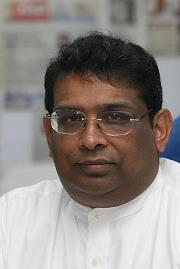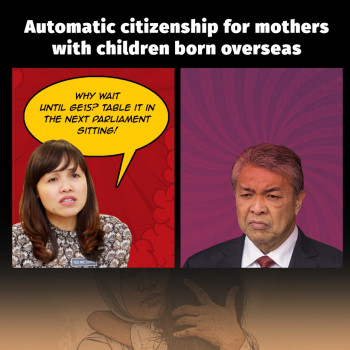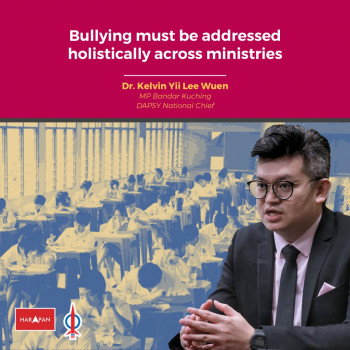by Norman Fernandez
 The government has announced that a comprehensive review of the education system is being carried out, and a report on the review of the country’s education system will be ready in three months. The review aims to improve the standard of education and narrow the disparities in the education system. The government has also said that if there was a need to amend any policy, it may consider as long as such an amendment would not change the entire perspective of education.
The government has announced that a comprehensive review of the education system is being carried out, and a report on the review of the country’s education system will be ready in three months. The review aims to improve the standard of education and narrow the disparities in the education system. The government has also said that if there was a need to amend any policy, it may consider as long as such an amendment would not change the entire perspective of education.
Immediately (and as usual) there are those who are calling for the implementation of a single stream education system, alleging that vernacular schools are an impediment to national unity.
Immediately, there are many who are proposing a restructuring of the national education system, including the implementation of a single stream to ensure attainment of the goals of a ‘1Malaysia’. As often the case, vernacular schools and principally Chinese schools have been singled out as being the root cause for polarisation and the lack of national unity. However, to fault vernacular schools for the cause for polarisation and disunity is premised on multiple fallacies.
Proponents of a single stream education system urge the government to follow Thailand where there are no Chinese schools or in the footsteps of Singapore which has abolished vernacular schools. However, they conveniently forget that in Malaysia, vernacular education is a right guaranteed by constitution and by acts of Parliament. Vernacular education is part of the social contract.
That right ought not to be questioned and the right to vernacular education is the right of the non-Malays and cannot be compromised.
Those who continuously fault the vernacular schools ought to be reminded that it is the desire and wish of every parent to see their children mix, study and play with children of other races. After all, the parents themselves were often the products of national schools where students of different races and religions studied, played and interacted together and forged friendship which extended long after they left school.
What those calling for single stream education and proponents for abolishing vernacular schools fail to admit is that vernacular schools in the past were not necessarily the schools of first choice for the non-Malays. Non-Malay parents sent their children to English-medium schools simply because the education was in English.
The schools had good teachers and English-medium schools provided school-leavers better career opportunities. In fact, Chinese schools such as Han Chiang High School in Penang were on the verge of closing down because of falling attendance and in the 70s, had to depend on students from Indonesia and Thailand to survive. Now the reverse has happened.
According to statistics, Chinese parents who send their children to national schools have fallen from around 50% in the 1970s to about 6% in 2006. The media has reported that 9 out of 10 Chinese send their children to Chinese vernacular schools. Today, there are approximately 630,000 students studying in 1,288 Chinese primary schools. Those blaming vernacular schools and particularly Chinese schools ought to know that there are almost 60,000 non-Chinese students studying in Chinese schools and a substantial proportion of these students are Malays.
Even more alarming is that Tamil parents and particularly Tamil professionals who were educated in national schools are now beating a path to the Tamil schools. Today, approximately 100,142 students study in 523 Tamil schools despite the fact that many Tamil schools lack the facilities national schools or Chinese schools have.
With Chinese and Indian parents abandoning national schools for vernacular schools, the national schools – not by choice – have taken on the image of ‘sekolah Melayu’. Those advocating single stream never bother to ask why have the non-Malays abandoned national schools and they are no more the schools of first choice.
 Rightfully those advocating single-stream education or proposing the closure of vernacular schools ought to ask the parents of the 60,000 non-Malay students (a substantial proportion of them being Malays) studying in Chinese schools, why did they as Malays abandon the national schools which have better facilities and teachers and students of same race and religion.
Rightfully those advocating single-stream education or proposing the closure of vernacular schools ought to ask the parents of the 60,000 non-Malay students (a substantial proportion of them being Malays) studying in Chinese schools, why did they as Malays abandon the national schools which have better facilities and teachers and students of same race and religion.
Why did they instead choose to send their children to Chinese vernacular schools where their children are a minority and will be exposed to Chinese culture, Chinese religious beliefs and having to eat in the school canteen which is more likely to serve food which may not be ‘halal’ or ‘qustionable’.
If fact, we hardly hear of cases of students being racially abused by teachers in Chinese schools.
Malay parents, seeing the benefits of a Chinese education, are also the abandoning national schools for Chinese schools. If Chinese schools are indeed the root cause of disunity then questions must be asked why the Malays are beginning to see Chinese schools as schools of first choice.
Instead, they repeat the decade old polemic blaming vernacular schools for causing racial polarisation and disunity. Further, they also conveniently choose to ignore that there are also schools which are exclusively for a single race, religious schools for a particular religion, universities catering to a single race and universities with religious orientation of a single religion. Are not the existence of these schools and universities equally divisive?
What logical justification is there to call for single-stream education in primary schools and then allow divisive secondary and tertiary education?
Malaysia is unique with its multiracial, multi-cultural and multi-religious population. The role of a school is not only to create a learning atmosphere. In Malaysia, schools have an added responsibility in that it ought to be a place where students are taught to value and celebrate diversity.
Students should be taught to acknowledge and respect each other’s culture, language and religion and to be imbibed with a sense that each other’s cultural, language and religious diversities are part and parcel of our national heritage and that this uniqueness should be treasured and protected by all. Schools must inculcate multi-racialism, multi-culturalism and multi-religionism. The question is whether the national schools are doing this.
The character of national schools have changed and they have become overtly and overwhelmingly Malay-Muslim. Malay-Muslim centred actions and policies have caused the exodus of non-Malays from the national schools.
School administrators and the principals in some national schools have turned the school and the school’s culture’s into one dominantly of Malay-Muslim. While great effort is taken to continuously remind the non-Malay students about respecting Malay cultural mores and religious sensitivities, the same is not done when it comes to non-Malay cultural and religious sensitivities. Even worse, they are blatantly indifferent to the sensitivities of the non-Malays.
Here is a letter which appeared in a news portal where a parent wrote: ‘In my children’s Sekolah Kebangssan school, the Hari Raya holidays are stretched to well over a week to accommodate the Malays. Replacement classes are planned months ahead and notification letters are sent out very early. However, when it comes to Chinese New Year, not a single extra day is given – not even for the kids who have to travel to make it to their hometowns. Mind you, Malays make up roughly 50% of the student population.’
Razak Baginda who was then the executive director of Malaysian Strategic Research Centre is quoted in the International Herald Tribune on June 7, 2005 as saying that his ‘daughter complained that the religious teachers are the culprits. They inculcate very negative views of the other religions. They are always have a ‘them and us’ attitude that is very destructive.’
This is merely one example. Many non-Malay parents also complain that while the school has religious and religious activities for Muslims students, it is a near impossibility to have the same for the non-Malay-non-Muslim students. In some schools, classes are segregated according to race and religion giving ‘time-table convenience’ as an excuse. Some schools even forbid their students from wearing shorts for physical education.
Thus, it was not a surprise when in 2002, the then prime minister Dr Mahathir Mohamed, without mincing his words, said that the national school system had been hijacked by obscurantists interested in Islamic practices that emphasise form over substance.
To add to the changing landscape of national schools, is a perception problem. Many parents lament that the standard of teaching in national schools has deteriorated. A lecturer at the teacher’s training college in Johor Baru once lamented about the quality of the trainee teachers.
According to him, many of these trainee teachers hardly have a passion for teaching and that teacher-training was their last choice after having failed to secure a place in the universities or other colleges.
Thus, the attraction to teaching is simply its perks – half-day sessions, five-day week and the long term breaks and more importantly, job security. Many have the perception that in the national schools, many of the teachers seem to be disinterested and unmotivated and some instead are more interested in moulding the children for the hereafter.
Rightly or wrongly, many believe that vernacular schools and particularly the Chinese vernacular schools have dedicated teachers with a reputation for quality, rigour and working their students hard. Could this be the reason why more than 60,000 non-Chinese students now study in Chinese schools ?
I believe the exodus in such droves from the national schools to the vernacular schools would not have happened had the government been farsighted and been quick to arrest the problem. Why did the government wait until almost 90% of the non-Malay students abandon the national schools before recognising that there was a problem
Surely the government ought to have known about the overzealous school administrators with their own agenda and about teachers who permeate ill-feelings and racism? The government must have known about the gradual Malay-nisation of these schools. There have been cases of non-Malay students who were racially abused to the extent of being called ‘monkeys’ ‘pendatangs’ and many other derogatory words . Such teachers rightfully out to have been dismissed with criminal action initiated. Instead, they were sent for ‘counseling’.
 On the issue of single stream education, the Prime Minister Najib Abdul Razak has rightly pointed out that any move to a single-stream education would require a big paradigm shift and it will only happen if the people are ready to make a change and if the society is not ready, the government will carry on with the existing system.
On the issue of single stream education, the Prime Minister Najib Abdul Razak has rightly pointed out that any move to a single-stream education would require a big paradigm shift and it will only happen if the people are ready to make a change and if the society is not ready, the government will carry on with the existing system.
That paradigm shift, I believe must come from the government. If only the government can walk the talk of a ‘1Malaysia’, take the necessary steps to overhaul the standard of national schools, enhance the quality and standard of teaching, ensure that schools are free from zealots and racists, employ teachers who are teachers and administrators who truly subscribe to multi-culturalism and multi-religionism, make the teaching of vernacular education mandatory and recreate the atmosphere of yesteryears (ie, pre- Merdeka), it is possible that the national schools could regain their past glory and their rightful place in Malaysian education. -The Rocket
* The writer is a practising lawyer and DAP Johor Deputy Chairman. Read The Rocket interview with him here .




Pingback: Another call to shut down Chinese and Tamil Primary Schools! | weehingthong